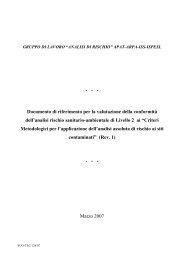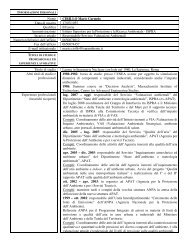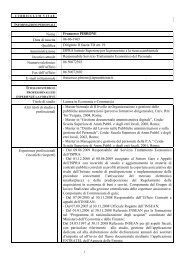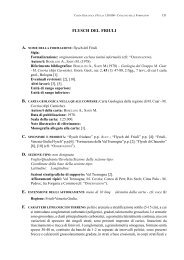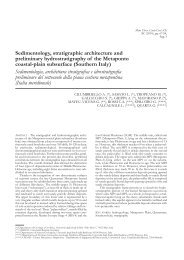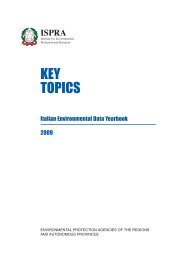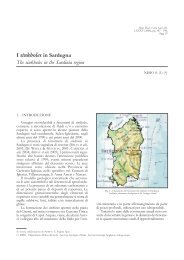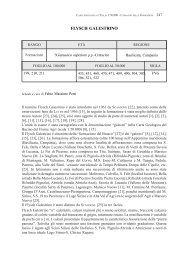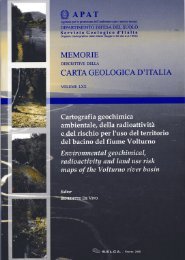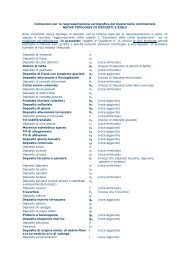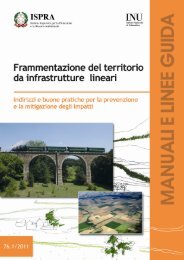Guidebook - Ispra
Guidebook - Ispra
Guidebook - Ispra
You also want an ePaper? Increase the reach of your titles
YUMPU automatically turns print PDFs into web optimized ePapers that Google loves.
Volume n° 1 - from PR01 to B15<br />
B12<br />
B12 -<br />
Leader: M. Sandulescu<br />
Stop 7.5:<br />
Bela Reka valley. Middle Lias.<br />
Upstream the Bela Reka valley, black shales with<br />
gritty intercalations of the Middle Lias crop out,<br />
characteristic for the Gresten facies. Their age is constrained<br />
by faunas with Ostrea cymbium, Belemnites<br />
paxillosus, Pholadomya sturi. Upwards they grade<br />
into the Upper Lias, with Posidonia bronni (Codarcea<br />
et al., 1961).<br />
Stop 7.6:<br />
Timiș valley between Teregova and Sadova Veche.<br />
Armeniș Formation of the Lotru Series.<br />
The lowermost term of the Lotru Series consists of<br />
nodular sillimanite-bearing biotite gneisses, pearlgneisses,<br />
quartz-feldspar gneisses, amphibolites and<br />
amphibole-gneisses, marbles and calc-silicate rocks<br />
(Savu, 1970; Săbău, 1994). Pegmatite veins are frequent.<br />
The top of the formation is represented by the<br />
thin Piatra Scrisă amphibolite level, overlain by almandine,<br />
kyanite and staurolite bearing micagneisses<br />
and schists (Săbău, 1994).<br />
Stop 7.7:<br />
Moniom. Relations between the Getic Reșiţa<br />
Nappe and the Supragetic Moniom Nappe.<br />
Leaving Moniom, the (Westphalian C.) Doman Beds<br />
of the Reșiţa Nappe will be crossed up to the Cârșie<br />
Hill, where they are overthrust by the metamorphic<br />
rocks of the Moniom Nappe along the Oraviţa tectonic<br />
line. The uppermost term of the Reșiţa Nappe is<br />
represented by the Carboniferous Cârșie Formation.<br />
It consists of metaconglomerates, metasandstones and<br />
phyllites. In the former, the pebbles decrease in size<br />
westwards. The stretching lineations are materialized<br />
by the N30 - 40°E / 10 -30°NE trending elongations<br />
of the pebbles. Analysis of the finite strain put in<br />
evidence its high intensity (Rf > 2,5) and its plane<br />
character. The Oraviţa tectonic line represents a post-<br />
Supragetic Nappe dextral transcurrent fault, inducing<br />
a simple shear in the Carboniferous formations (M.<br />
Dimitrescu, 2000).<br />
Westwards along the Bârzava river, the Devonian<br />
Valea Satului Formation of the Moniom Nappe consists<br />
of chlorite-epidote-actinolite-albite schists (±<br />
quartz, sericite, calcite) representing mylonitic basic<br />
metatuffs, metatuffites and metaaglomerates, with<br />
intercalations of carbonatic and graphitic rocks, acid<br />
metatuffs also being present, as well as metagabbroic<br />
intrusions.<br />
The described formations exhibit subhorizontal ini-<br />
tial stratification surfaces (S 0 ) and almost vertical S 2<br />
cleavages.<br />
The Valea Satului Formation was parallelized with<br />
the Leșcoviţa “Series” exposed along the Danube (V.<br />
Iancu, in: Năstăseanu et al., 1981).<br />
Stop 7.8:<br />
Colţan tunnel. Bocșa Nappe overthrust onto the<br />
Moniom Nappe.<br />
Along the Bârzava valley, above the Colţan railway<br />
tunnel, the Valea Satului Formation of the Moniom<br />
Nappe is overthrust by the Bocșiţa-Drimoxa Formation<br />
of the Bocșa Nappe. The latter formation consists<br />
of muscovite-chlorite-albite plagiogneisses, with biotite<br />
and garnet relics ( mainly enclosed in plagioclase<br />
porphyroblasts); it crops out about 200 m west of the<br />
forest chalet. The rocks exhibit intrafolial transposition<br />
folds, the limbs of which are cut by a S2 foliation<br />
with a westward dip. Westwards, the plagiogneisses<br />
alternate with rare microcline augengneisses and<br />
orthoamphibolites (V. Iancu, in: Năstăseanu et al.,<br />
1981).<br />
The Mesozoic cover of the basement formations is<br />
represented by marbles, the age of which is ascribed<br />
to the Middle-Upper Jurassic-Lower Cretaceous.<br />
The Bocșiţa-Drimoxa Formation was parallelized<br />
with the Locva “Series” exposed along the Danube<br />
(V. Iancu).<br />
Stop 7.9:<br />
Bârzava valley - Bocșa Nouă. Banatitic massif.<br />
The contact zone between the Bocșa banatitic pluton<br />
and the intruded Supragetic augen-and plagiogneisses<br />
is exposed. A first intrusion of micromonzodiorite<br />
porphyry is penetrated by a granodiorite, carrying<br />
xenoliths of both crystalline schists and eruptive<br />
rocks. The micromonzodiorite porphyry of the early<br />
magmatic stage (Western Unit) contains large hornblende<br />
and biotite phenocrysts. The monzogranites<br />
and granodiorites Medium Unit consists of zoned<br />
plagioclase (20-35 % An), microcline, quartz, biotite<br />
and hornblende (Russo-Săndulescu et al., 1975; in<br />
Năstăseanu et al., 1981).<br />
The respective K - Ar ages of the succesive intrusions<br />
are 87 m.y. (B 1) and 80 - 81 m.y. (B2) that is, intra<br />
- Senonian.<br />
Acknowledgements<br />
The authors would like to express their gratitude to<br />
Dr. Mihaela Dimitrescu, Miss Elena Negulescu and<br />
Miss Delia-Georgeta Dumitraș (Geological Institute



